Peperomia plants have a small stature, but big personalities. These compact plants feature stunning foliage in various shades of green, texture, and shape. They are considered easy-to-grow, and are very tolerant of different growing conditions, which makes them ideal for beginners.
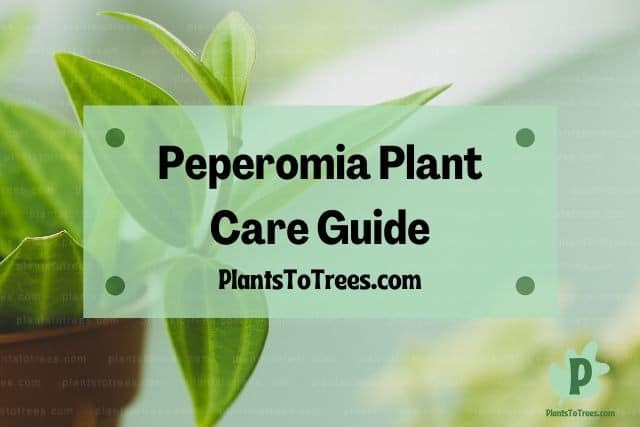
Following a peperomia plant care guide will help you better understand the needs of this attractive and popular houseplant. For example, this plant needs indirect but bright sunlight, temperatures that are no lower than 65 degrees, and likes a good amount of oxygen near its roots.
Another benefit of peperomia plants is that they don’t have many problems that gardeners have to deal with, and diseases are not a real concern as long as you give the peperomia the proper care. They also require little maintenance. A downside for some, however, is that this plant is a slow grower and often doesn’t even require repotting.
If, however, you are looking for a compact plant that requires little attention, but will bring interesting foliage to your indoor gardener, look no further than the peperomia plant.
Other Names Of Peperomia Plant
It’s rather common for plants to go by a few different monikers, and the peperomia plant is no different.
The peperomia plant is known by a wide array of names, including pepper elder, shining bush plant, radiator plant, baby rubber plant, and emerald ripple pepper. Despite the different names, it is all the same plant in the Piperaceae family.
Because some plants share the same or similar names, it can be difficult to determine if the info you are looking for is exactly for the plant you are growing. This is when the plant’s scientific name comes in handy. The scientific name for peperomia plants is Peperomia spp.
Frost Tolerance And USDA Hardiness Zones Of Peperomia Plant
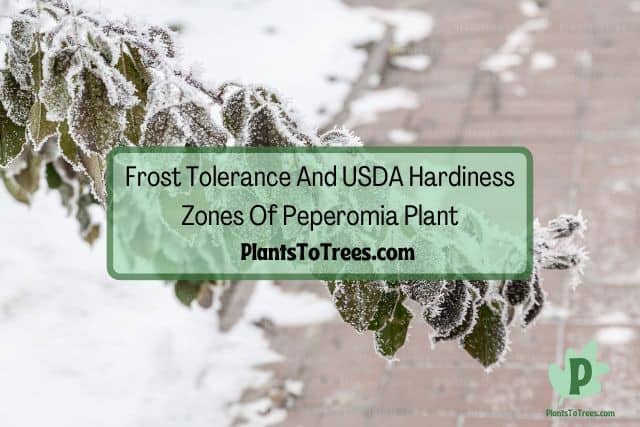
One of the first things all indoor and outdoor gardeners should learn before bringing a plant home is what USDA hardiness zones it can grow in.
Peperomia plants can grow indoors in any USDA hardiness zone. Unfortunately, this plant isn’t frost tolerant and can only grow outdoors in zones 10 to 12. It’s ideal temperature is between 65 and 75 degrees Fahrenheit, and it cannot handle temps below 50 degrees.
Unsure of what zone you live in? Visit the USDA Plant Hardiness Zone Map and enter your zipcode. It’s that easy and only takes a few moments of your time.
How Many Hours Of Sunlight Does Peperomia Plant Need?
Sunlight is vital for peperomia plants, but giving it too much can cause it to dry out faster, wilt, and even stunt its growth.
Peperomia plants with green foliage need about 5 to 6 hours of sunlight every single day. Varieties with variegated leaves will need a bit more sunlight, however, in order to maintain their variegated foliage. Not giving them this amount of sunlight will result in a slow down of their growth.
If you continue to deprive the peperomia plant of sunlight, their growth will stop altogether and the plant’s health will suffer. Variegated peperomia plants run the risk of also losing their variegation if they don’t get enough sunlight.
Peperomia Plant Needs Direct Or Indirect Sunlight?

When trying to determine where to place your peperomia plant, it’s important to learn whether it needs direct or indirect sun. Direct sunlight can be rather harsh, and putting a plant that cannot tolerate it will result in unpleasant side effects on its foliage.
Peperomia plants need indirect sunlight that is bright and plentiful. An east-facing or west-facing window with a sheer curtain provides the ideal amount of sunlight while still filtering the harsh direct rays of the sun.
If you don’t have a sheer curtain, simply move the plant away from the window a bit. You may have to play around with the exact location and distance away from the window. If you spend a day or two watching how and where the sunlight comes in through the window, you will be able to determine the perfect location for the peperomia plant to receive bright, indirect light.
Is Peperomia Plant An Indoor Plant, Outdoor Plant Or Both?
When deciding where to grow peperomia plants, it’s important to first learn whether these plants require the safety of the indoors or if they can grow freely outside.
Whether or not peperomia plants are indoor or outdoor plants depends on your location. In most areas, the peperomia plant can only be grown indoors. If, however, you live in USDA hardiness zones 10 to 12, you can grow the plant outside.
What Are The Indoor Lighting Requirements For A Peperomia Plant?

One of the benefits of growing peperomias is that their lighting requirements are similar to most other popular houseplants. This means you can easily incorporate the peperomia plant into your indoor garden.
Peperomia plants need bright sunlight that is filtered, which means indirect light. Placing the plant in direct sunlight will increase the chance of the plant’s leaves burning or scorching. It will also take a serious toll on the overall health of the plant.
No need to fret if you don’t have an available window that matches the lighting requirements. Peperomia plants do well under artificial light, and supplementing their lighting requirements with grow lights will give them the proper amount of light they need indoors.
What Are The Outdoor Lighting Requirements For A Peperomia Plant?
For most plants, the lighting requirements are about the same whether they are grown indoors or outdoors, and the peperomia plant is no different.
Growing the peperomia plant outdoors requires about the same type of lighting as growing it indoors. Choose a location where the plant will have dappled light and be protected from strong winds and heavy rainfall.
Remember, the peperomia plant can only grow outdoors in USDA hardiness zones 10 to 12. Trying to grow this plant outside of these zones will result in the peperomia succumbing to frost.
You can, however, take the plant outdoors on warm spring and summer days if you live in zones below 10. Just make sure to bring the plant back inside before the temperatures fall under 65 degrees.
What Soil Requirements Does Peperomia Plant Need?
The type of soil you use to grow your peperomia plant is extremely important. Choosing the wrong soil will increase your chance of overwatering the plant and put its health in danger.
Like other houseplants, the peperomia plant needs soil that drains well. Its roots need an abundance of oxygen, so enhance houseplant potting mix by mixing in some perlite or sand. In addition, only plant the peperomia in a pot that has drainage holes at the very bottom of the container.
A lot of pots have drainage holes along the side, and while this may seem like sufficient for drainage, it can actually keep the soil and roots soggy. If the drainage holes are on the side of the container, the water has to reach those holes before it will drain out. When the holes are on the bottom, all the excess water drains out as it works its way through the soil.
How Much Water Does a Peperomia Plant Need?
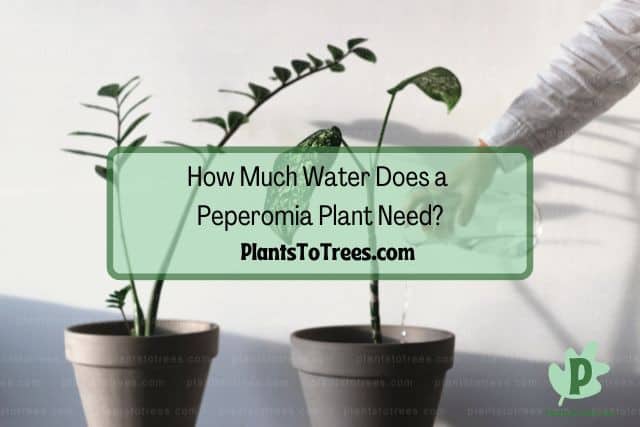
As all gardeners know, water is an important part of growing any plant. And knowing how much water a plant needs can help you avoid overwatering or underwatering your houseplants.
Peperomia plants typically require watering once every one to two weeks. This plant likes for the soil to dry out a bit in between waterings. Several factors can influence how often you will need to water the plant, including the temperature and humidity level, age of the plant, and the lighting.
If the plant gets brighter light, it will need more watering than a plant that gets lower light. Because there are so many different factors that can affect how often and how much water, it is best to manually test the soil’s moisture level instead of simply watering on a set schedule.
Is My Peperomia Plant Overwatered, What Are The Symptoms?
Overwatering is a far too common problem that affects houseplants of all types, including peperomia plants. While no one really means to overwater their plants, it is a serious issue that is easily avoided. Unfortunately, once you start seeing symptoms of an overwatered plant, it may be too far gone to save.
Limp foliage, mold on the surface of the soil, and mushy stems are all signs that your peperomia plant is overwatered. If the overwatering continues, water-filled blisters will start to form on the leaves and stems, and root rot will occur. Root rot will eventually kill the peperomia plant.
Once you realize you have been overwatering your plant, immediately stop watering and allow the soil to dry out before you start watering again. For plants that have been overwatered for some time, you may have to discard the plant and start fresh with a new one.
One option to try, however, before you toss the overwatered peperomia into the trash is to remove the entire plant from its container. Use your hands to gently remove all the soil from around the roots. Snip off any damaged, diseased, or brown roots, and then plant the peperomia in fresh soil and a clean pot.
Is My Peperomia Plant Underwatered, What Are The Symptoms?
Underwatering is not nearly as common as overwatering, but it does occur. The good news is that in most cases, underwatering can be reversed and the peperomia plant usually recovers.
Curling leaves that feel crispy and dry are the most common symptoms of an underwatered peperomia plant. The leaves may also discolor to a gray or light brown, and they can fall off the plant. The soil will also be dry, and the plant’s growth will slow.
While an underwater peperomia plant isn’t as serious as an overwatered one, you still want to ensure you are giving the plant water when needed. If you are faced with an underwatered peperomia, you cannot simply hydrate the plant as you normally would. Instead, you will need to soak the plant in a bucket filled with water. A good 30 or so minutes in water is usually all that is needed to help an underwatered plant.
How Much Fertilizer Does Peperomia Plant Need? What Kind?
Fertilizers are not often thought of for houseplants, and it is not uncommon for indoor gardeners to forgo giving the plants a little food every once and a while. The truth is, peperomia, like most other houseplants, would greatly benefit from regular applications of fertilizer.
Peperomia plants like a balanced fertilizer, such as 20-20-20, fed to them once every two weeks during their active growing season, which is in the spring and summer. Dilute the fertilizer by ½ strength before feeding it to the peperomia. Only feed the plant once a month in fall and winter.
Because you can overfeed a peperomia plant, it is best to follow the warnings and application instructions found on the fertilizer bottle. And never feed the plant more than the recommended dosage.
Peperomia Plant Diseases To Be Aware Of
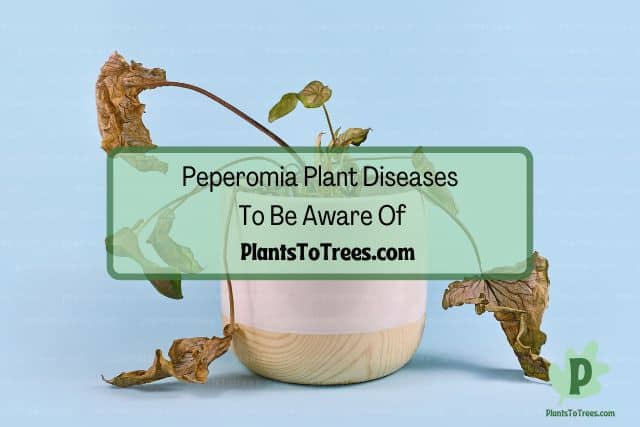
The best defense against plant diseases is to ensure your peperomia plant is healthy and strong. A healthy, strong plant is more likely to withstand an attack from common diseases. You should also familiarize yourself with what can affect peperomia plants, since knowing what to look for will help you quickly recognize when a problem starts to arise.
Peperomias are susceptible to only a few plant diseases, most of which are typically easy to prevent and treat. The most common diseases affecting peperomias are oedema, ring spot, cutting rot, and phytophthora rot.
Oedema, which is also known as edema, is still not very well known, and the jury is still out on what can cause this disease. With that said, however, experts think it could possibly be a virus. What is known about this disease is that it causes small raised bumps, like pimples, to form on the tops and undersides of the affected plant’s leaves. These bumps start off as a dark green before turning brown and sometimes sunken. In extreme cases, oedema can cause affected leaves to be malformed.
Ring spot is another common disease that can affect peperomia. This disease is caused by a virus that is typically spread when cuttings are taken from the plant. The most common symptom of ring spot is brown rings forming on leaves that start to curl, twist, or cup.
Cutting rot is caused by various soil-borne fungi, and will cause cuttings to develop watersoaked blisters along the petioles and leaf blades. These blisters will have a black or brown color. As the disease progresses, it will start to decay the roots of the plants. Not overwatering the peperomia and making sure it is growing in well-drained soil goes a long way to preventing these fungal diseases.
Like cutting rot, phytophthora rot is caused by soil-borne fungi and occurs when the plant is overwatered and/or growing in soil with bad drainage. The symptoms of phytophthora rot include girdling and blackening of the stem. These symptoms will start to progress to the leaves, and the entire plant will begin to wilt and eventually die.
Are There Different Types Of Peperomia Plants?
One thing to consider before growing a peperomia is whether or not there are different types of this plant available. Most plants have at least a few different varieties, with different colors, textures, and sizes available.
While there are over 1,500 peperomia varieties out there, the 4 most common are baby rubber plant, red edge peperomia, watermelon peperomia, and ripple peperomia. These are the peperomia varieties you are most likely to find at your local nursery or garden center.
The baby rubber plant (Peperomia obtusifolia) has glossy green leaves shaped like a spoon and thick stems that stand upright. This variety is available in variegated and non-variegated foliage.
As its name suggests, the red edge peperomia (Peperomia clusiifolia) features leaves with a reddish ting at its margins. The elongated, wavy leaves are green in color and can be either variegated or non-variegated.
Watermelon peperomia (Peperomia argyreia) is named because of the pattern of the plant’s leaves, which resemble the exterior of a watermelon. The large, green waxy leaves are striped with a cream color and have a smooth texture.
The ripple peperomia (Peperomia caperata) has heart-shaped leaves that feature ridged leaves. These leaves are dark green with reddish to purplish colored stems.
How To Propagate Peperomia Plant
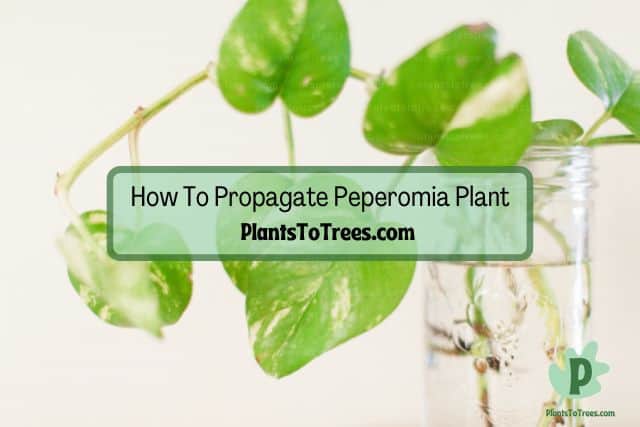
Why would someone want to propagate a peperomia plant? There are many reasons as to why, but the most common one is to simply increase the amount of plants you have without buying an entirely new plant. Just think, you could double or even triple the amount of houseplants you already have just by utilizing the current plants you are growing.
Peperomia plants can be propagated in various different ways, such as stem cutting, leaf cutting, in soil, and in water. The method you choose will depend on your personal preference, as well as the type of peperomia plant you are taking a cutting from.
Before you even begin the propagating process, you should consider the health of the plant. Since peperomia plants are susceptible to a few diseases that occur due to propagating diseased plants, it is vital to ensure you only propagate from completely healthy plants.
Stem cutting can be used for any type of peperomia plant, and it should be the only propagating method for variegated varieties. If you try to take a leaf cutting of a variegated plant, the variegation may not transfer to the new plant. To take a stem cutting, simply cut a stem just above a node. Use a clean pair of pruning shears or sharp knife to do the cutting. Remove the bottom leaves from the cutting and then root it in either water or soil.
Leaf cuttings are not a good choice for variegated peperomia plants, but they work well for the non-variegated varieties. For this type of propagation, you will need to select a leaf that is hearty and rather big. Using a sharp pair of pruning shears, cut the leaf off the plant just below its leaf blade, making sure to leave a tiny bit of stem on the leaf.
Once you have your cutting, either stem or leaf, dip the cut end in rooting powder and then plant it in the soil. Use soil that is light, airy, and drains well. A mixture of potting soil, coco coir, and perlite is a good choice. Once the cutting has been planted, cover it with a plastic bag to create a greenhouse-like environment around the cutting. Set the pot near a window where it will get indirect sunlight and mist or water when the soil feels dry. It should take about 2 to 3 weeks for roots to form.
For water propagation, simply fill a jar, vase, or container with water and then place the cut end of the cutting into the water. Cover the water-filled container with a plastic bag and set it in a location where it will get indirect sunlight. Change the water once a week.
Is a Peperomia Plant Toxic To Humans?
Did you know that many of the most popular houseplants can pose a risk to your health? You may have a plant in your house right at this minute that is considered toxic to humans. Thankfully, most plants are only mildly toxic and won’t cause any long-term health effects. You should, however, know whether or not a plant is toxic before bringing it into your home.
Peperomia plants are not toxic to humans, which makes them a good choice for homes with small children. This means that if your little one bothers, chews, or even ingests any parts of the plant it won’t cause ill effects.
We at Plants To Trees first published this article on October 25, 2022. Copyright protected.
Is a Peperomia Plant Toxic To Dogs?
Houseplants can brighten your home, improve your indoor air quality, and boost your mood. Unfortunately, many of the most common houseplants are also dangerous to man’s best friend. The question is, do peperomia plants pose a danger to your dog?
Thankfully, peperomia plants are not listed as toxic to dogs, and you can safely grow these plants indoors with your four-legged friend. With that said, you should still not allow your dog to chew or play with any houseplants, even non-toxic ones.
This only encourages behavior that could lead to them nibbling on potentially dangerous plants. Instead, actively teach your pooch that houseplants are not toys and they should simply leave them be. This can help keep your dog safe in the future,
Is a Peperomia Plant Toxic To Cats?
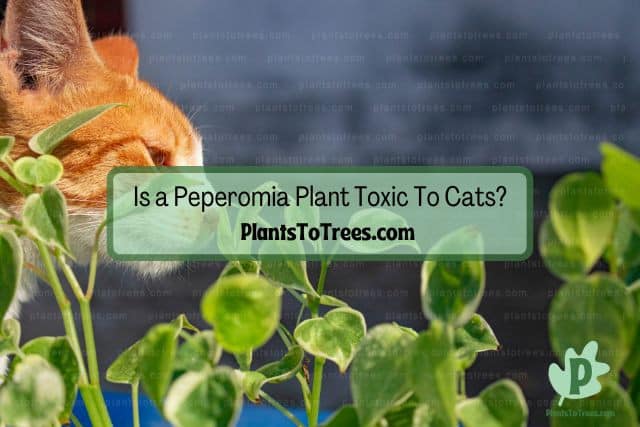
Having indoor plants when you also have cats can be tricky. Especially when you start to learn about the many different popular houseplants that actually pose a risk to the health and well-being of your feline friend.
The good news is that peperomia plants are not toxic to cats, and won’t cause harm if your kitty ingests any parts of this plant. Aim, however, to keep your cat away from houseplants. If you want to give your cat their own greenery, consider growing cat grass for your kitty.
The article owner is Plants To Trees dot Com and this article was first published on October 25, 2022.
Growing houseplants, both toxic and non toxic, in a hanging basket is a wonderful way to ensure they stay out of your cats reach while still bringing the benefits of nature indoors.
Related Articles
Chinese Evergreen Plant Care Guide
PlantsToTrees.com is the owner of this article and we first published this on October 25, 2022.
